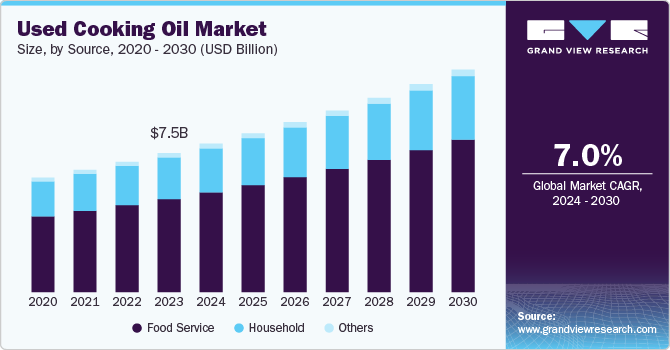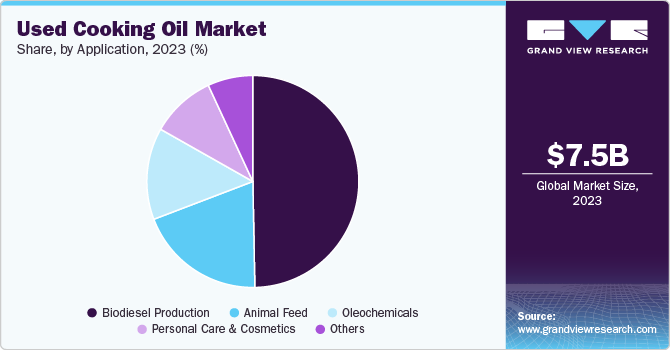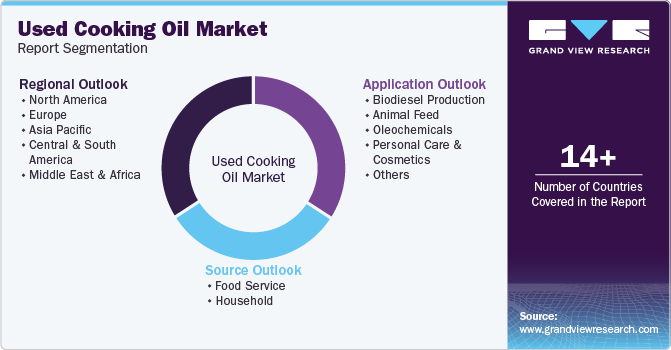- Home
- »
- Consumer F&B
- »
-
Used Cooking Oil Market Size & Share, Industry Report 2030GVR Report cover
![Used Cooking Oil Market Size, Share & Trends Report]()
Used Cooking Oil Market Size, Share & Trends Analysis Report By Source (Food Service, Household), By Application (Biodiesel Production, Animal Feed), By Region, And Segment Forecasts, 2024 - 2030
- Report ID: GVR-4-68040-490-3
- Number of Report Pages: 80
- Format: PDF, Horizon Databook
- Historical Range: 2018 - 2022
- Forecast Period: 2024 - 2030
- Industry: Consumer Goods
Used Cooking Oil Market Size & Trends
The global used cooking oil market size was estimated at USD 7.49 billion in 2023 and is projected to grow at a CAGR of 7.0% from 2024 to 2030. One of the primary drivers of the used cooking oil (UCO) industry is the global shift towards renewable energy sources. Governments worldwide are implementing regulations and providing incentives to promote the recycling of used cooking oil for biodiesel production. Biodiesel, as an eco-friendly alternative to traditional fossil fuels, significantly reduces greenhouse gas emissions and supports renewable energy initiatives. This trend is particularly prominent in regions like Europe and North America, where stringent environmental regulations are in place to encourage the use of biodiesel.

The foodservice industry also plays a crucial role in driving the demand for used cooking oil. The increasing number of restaurants, cafes, and food stalls contributes to a higher volume of waste cooking oil available for recycling. As consumer preferences shift toward dining out and trying diverse cuisines, the foodservice sector's expansion is expected to further increase the availability of used cooking oil. In addition, many establishments are adopting sustainable practices by partnering with waste management companies to recycle their used cooking oil, thus creating a steady supply for biodiesel producers.
Technological advancements in waste recycling processes have also bolstered market growth. Innovations that enhance the efficiency of converting used cooking oil into high-quality biodiesel and other products have made it more appealing for manufacturers. These developments not only improve product quality but also reduce production costs, making UCO a more competitive raw material compared to virgin vegetable oils.
Furthermore, there is a growing awareness regarding the benefits of using used cooking oil beyond biodiesel production. Used cooking oil is increasingly being utilized in various applications such as animal feed, oleo chemicals, and even cosmetics. This diversification of applications helps to stabilize demand across different sectors, further solidifying the market's growth potential.
A major challenge in the used cooking oil industry is supply chain disruptions. The logistics involved in collecting, transporting, and processing used cooking oil can be complicated. Issues such as transportation delays, border closures, and inadequate infrastructure for collection can hinder the efficient flow of UCO from collection points to processing facilities. These disruptions can lead to increased costs and reduced availability of used cooking oil in the market.
Quality control is also a significant concern in the used cooking oil industry. The quality of used cooking oil can vary greatly depending on its source and previous usage. High levels of impurities, such as free fatty acids and water, must be removed before the oil can be effectively processed into biodiesel or other products. If not adequately addressed, these impurities can lead to lower yields in biodiesel production and may even render the oil unsuitable for certain applications, such as animal feed.
Source Insights
Used cooking oil from the food service industry held the largest revenue share, exceeding USD 5 billion in 2023. One of the key drivers is the increasing number of restaurants and food establishments worldwide. The National Restaurant Association reported that sales in U.S. restaurants reached approximately USD 825 billion in 2018, with a consistent growth rate. This expansion leads to higher volumes of waste cooking oil, which can be collected and recycled for biodiesel production and other applications. As more eateries adopt sustainable practices, they are increasingly partnering with waste management companies to ensure their used cooking oil is collected efficiently, thereby enhancing the supply chain for used cooking oil.
Moreover, the growing consumer interest in sustainability has prompted many food service establishments to adopt eco-friendly practices. Restaurants are now more aware of their environmental impact and are actively seeking ways to reduce waste. This includes recycling used cooking oil, which not only helps in waste management but also provides an additional revenue stream by selling it to biodiesel producers. Such initiatives are supported by government policies promoting renewable energy sources and sustainability, further driving the demand for UCO from the food service sector.
Government regulations and incentives aimed at promoting sustainable practices within the food service industry have been instrumental. Many countries have implemented policies requiring restaurants to dispose of their used cooking oil responsibly, often mandating recycling programs. These regulations not only facilitate better waste management but also encourage establishments to engage with collection services that can process their used cooking oil into biodiesel or other products.
The other crucial source of used cooking oil is the household sector, which accounted for 30% of the market share in 2023. A significant driver is the rising consumer awareness regarding environmental sustainability. As individuals become more conscious of their ecological footprint, many households are actively seeking ways to reduce waste. Used cooking oil, once discarded, is now recognized for its potential to be repurposed into biodiesel and other valuable products. This shift in perception encourages households to participate in recycling initiatives, contributing to a more robust supply of used cooking oil for processing into renewable energy sources. The increased consumption of cooking oils in households also plays a crucial role in the growth of the UCO market..
Technological advancements in collection and processing methods have made it easier for households to recycle their used cooking oil. Innovations such as home collection systems or partnerships with local recycling companies allow residents to dispose of their used oil conveniently and responsibly. This accessibility encourages more households to engage in recycling practices, thereby increasing the overall supply of used cooking oil available for biodiesel production and other applications.
Application Insights
Biodiesel production was the largest application for used cooking oil and had a market revenue of USD 3.72 billion in 2023. One of the primary drivers is the increasing demand for renewable energy sources. As global awareness of climate change and environmental sustainability rises, there is a significant push towards reducing greenhouse gas emissions. Biodiesel produced from used cooking oil is recognized as a cleaner alternative to traditional fossil fuels, contributing to this shift. It emits lower levels of carbon dioxide and particulate matter when burned, making it an attractive option for countries aiming to meet their carbon reduction targets and transition to greener energy solutions.
The cost-effectiveness of used cooking oil compared to virgin oils is another crucial factor propelling its use in biodiesel production. As a result, many producers are increasingly turning to UCO as a primary feedstock for biodiesel production, thus driving market growth. Technological advancements in waste recycling processes have also contributed significantly to the growth of the used cooking oil industry in biodiesel production. Enhanced processing techniques allow for better extraction and purification of oil, increasing yield and product quality while reducing operational costs.
Animal feed was the second most important application for used cooking oil and is expected to grow at a CAGR of 6.3% from 2024 to 2030. One of the primary reasons for this growth is the nutritional value of used cooking oil. Used cooking oil is rich in essential fatty acids and energy, making it a valuable supplement in animal feed formulations. By adding used cooking oil to feed, producers can enhance the energy density of the diet, which is particularly beneficial for livestock such as pigs and poultry that require high-energy diets for optimal growth and production. This nutritional advantage encourages farmers to utilize UCO as a cost-effective feed ingredient.
The economic benefits associated with using used cooking oil in animal feed also play a significant role in its market growth. The affordability of UCO presents an attractive alternative for livestock producers looking to manage their costs while maintaining feed quality. This economic incentive drives demand for UCO as a supplementary ingredient in animal nutrition.

The oleochemicals industry is increasingly utilizing used cooking oil, and the market is expected to exceed USD 1.69 billion by 2030. Oleochemicals derived from used cooking oil find applications in numerous sectors, including personal care, household cleaning products, lubricants, and pharmaceuticals. The versatility of these chemicals increases their market potential and encourages manufacturers to invest in used cooking oil processing facilities. As demand for bio-based ingredients grows across various industries, the utilization of UCO in oleochemical production is expected to expand significantly.
The economic advantage of utilizing waste cooking oil is that it helps reduce overall production costs while maintaining quality. As the prices of traditional feedstocks fluctuate, the affordability of UCO makes it an attractive option for producing various oleochemical derivatives, such as fatty acids and esters.
Regional Insights
The North America cooking oil market held the largest global revenue share, exceeding USD 3 billion in 2023. North America, particularly the United States, has a significant demand for biodiesel as a renewable energy source. The U.S. biodiesel market is projected to grow substantially, with UCO serving as a primary feedstock due to its cost-effectiveness and availability. In North America, there are various policies encouraging the collection and recycling of waste cooking oil from restaurants, hotels, and food service establishments. These legislative frameworks not only facilitate the growth of UCO collection but also incentivize businesses to adopt eco-friendly practices.

U.S. Used Cooking Oil Market Trends
The U.S. used cooking oil market is expected to grow at a CAGR of 6.6% from 2024 to 2030. The rapid expansion of the food service industry in the U.S. contributes significantly to the availability of used cooking oil. As more restaurants, cafes, and food outlets open, the volume of waste cooking oil generated increases correspondingly. This trend is expected to continue, providing a steady supply of used cooking oil for recycling into biodiesel and other products.
Asia Pacific Used Cooking Oil Market Trends
The used cooking oil market in Asia Pacific is expected to be the fastest growing at a projected CAGR of 7.8% from 2024 to 2030. Countries in Asia-Pacific, particularly China and India, are experiencing significant urbanization and industrial growth. As urban populations expand, there is an increase in food consumption and, consequently, the generation of used cooking oil. This surge in used cooking oil production creates ample opportunities for collection and recycling initiatives aimed at converting waste into valuable resources like biodiesel.
Governments in countries in Asia are increasingly implementing policies and incentives to promote renewable energy sources, including biodiesel derived from used cooking oil. For instance, China has established initiatives to support the conversion of used cooking oil into biofuels as part of its broader strategy to reduce carbon emissions and enhance energy security. These supportive measures encourage both the collection and processing of UCO, driving market growth.
Key Used Cooking Oil Company Insights
The used cooking oil industry features a competitive landscape with several established players committed to sustainability through recycling initiatives. As demand for renewable energy sources continues to rise alongside regulatory support, companies involved in the collection and processing of UCO are well-positioned for growth within this evolving market.
Key Used Cooking Oil Companies:
The following are the leading companies in the used cooking oil market. These companies collectively hold the largest market share and dictate industry trends.
- Valley Proteins, Inc.
- Baker Commodities Inc.
- Arrow Oils Ltd.
- Olleco
- Waste Oil Recyclers
- Grand Natural Inc.
- Greasecycle
- Brocklesby Limited
- Oz Oils Pty Ltd
- Proper Oils Company Ltd
- Darling Ingredients Inc.
- Argent Energy
- Greenergy International Ltd.
- Mahoney Environmental
- SeQuential
Recent Developments
- In November 2024, Darling Ingredients Inc. launched DarLinQ, a real-time technology that utilizes cutting-edge Bluetooth and sonar technologies that enable continuous, accurate oil-level monitoring of used cooking oil (UCO) storage containers through custom, automated equipment to improve operational efficiency and security.
Used Cooking Oil Market Report Scope
Report Attribute
Details
Market size value in 2024
USD 8.01 billion
Revenue forecast in 2030
USD 11.98 billion
Growth Rate (Revenue)
CAGR of 7.0% from 2024 to 2030
Actuals
2018 - 2022
Forecast period
2024 - 2030
Quantitative units
Revenue in USD billion and CAGR from 2024 to 2030
Report coverage
Revenue forecast, company ranking, competitive landscape, growth factors, and trends
Segments covered
Source, application, region
Regional scope
North America; Europe; Asia Pacific; Central & South America; Middle East & Africa
Country scope
U.S, Canada, Mexico, Germany, UK, France, Italy, Spain, China, Japan, India, Australia & New Zealand, South Korea, Brazil, South Africa
Key companies profiled
Valley Proteins, Inc.; Baker Commodities Inc.; Arrow Oils Ltd.; Olleco; Waste Oil Recyclers; Grand Natural Inc.; Greasecycle; Brocklesby Limited; Oz Oils Pty Ltd; Proper Oils Company Ltd; Darling Ingredients Inc.; Argent Energy; Greenergy International Ltd.; Mahoney Environmental; SeQuential; Victorian Used Cooking OilGroves (Australia); Gourmet Foods Inc. (U.S.); Used Cooking OilLine International S.L.; Chrisnas Olives; Agrotiki S.A
Customization scope
Free report customization (equivalent up to 8 analysts working days) with purchase. Addition or alteration to country, regional & segment scope. Pricing and purchase options
Avail customized purchase options to meet your exact research needs. Explore purchase options Global Used Cooking Oil Market Report Segmentation
This report forecasts revenue growth at the global, regional, and country levels and provides an analysis of the latest industry trends and opportunities in each of the sub-segments from 2018 to 2030. For this study, Grand View Research has segmented the global used cooking oil market report based on source, application, and region.

-
Source Outlook (Revenue, USD Billion, 2018 - 2030)
-
Food Service
-
Household
-
-
Application Outlook (Revenue, USD Billion, 2018 - 2030)
-
Biodiesel Production
-
Animal feed
-
Oleochemicals
-
Personal Care & Cosmetics
-
Others
-
-
Regional Outlook (Revenue, USD Billion, 2018 - 2030)
-
North America
-
U.S.
-
Canada
-
Mexico
-
-
Europe
-
Germany
-
UK
-
France
-
Italy
-
Spain
-
-
Asia Pacific
-
China
-
Japan
-
India
-
Australia & New Zealand
-
South Korea
-
-
Central & South America
-
Brazil
-
-
Middle East & Africa
-
South Africa
-
-
Frequently Asked Questions About This Report
b. The global used cooking oil market was valued at USD 7.49 billion in 2023 and is expected to reach USD 8.01 billion in 2024.
b. The global used cooking oil market is expected to expand at a compound annual growth rate (CAGR) of 7.0% from 2024 to 2030 to reach USD 11.98 billion by 2030.
b. Biodiesel production was the largest application for used cooking oil and had a market revenue of USD 3.72 billion in 2023. One of the primary drivers is the increasing demand for renewable energy sources. As global awareness of climate change and environmental sustainability rises, there is a significant push towards reducing greenhouse gas emissions. Biodiesel produced from used cooking oil is recognized as a cleaner alternative to traditional fossil fuels, contributing to this shift.
b. Some key players operating in theused cooking oil market include Valley Proteins, Inc.; Baker Commodities Inc.; Arrow Oils Ltd.; Olleco; Waste Oil Recyclers; Grand Natural Inc.; Greasecycle; Brocklesby Limited; Oz Oils Pty Ltd; Proper Oils Company Ltd; Darling Ingredients Inc.; Argent Energy; Greenergy International Ltd.; Mahoney Environmental; SeQuential; Victorian Used Cooking OilGroves (Australia); Gourmet Foods Inc. (U.S.); Used Cooking OilLine International S.L.; Chrisnas Olives; Agrotiki S.A
b. One of the primary drivers of the used cooking oil (UCO) market is the global shift towards renewable energy sources. Governments worldwide are implementing regulations and providing incentives to promote the recycling of used cooking oil for biodiesel production. Biodiesel, as an eco-friendly alternative to traditional fossil fuels, significantly reduces greenhouse gas emissions and supports renewable energy initiatives. This trend is particularly prominent in regions like Europe and North America, where stringent environmental regulations are in place to encourage the use of biodiesel.
Share this report with your colleague or friend.
![gvr icn]()
NEED A CUSTOM REPORT?
We can customize every report - free of charge - including purchasing stand-alone sections or country-level reports, as well as offer affordable discounts for start-ups & universities. Contact us now
![Certified Icon]()
We are GDPR and CCPA compliant! Your transaction & personal information is safe and secure. For more details, please read our privacy policy.
We are committed towards customer satisfaction, and quality service.
"The quality of research they have done for us has been excellent."





